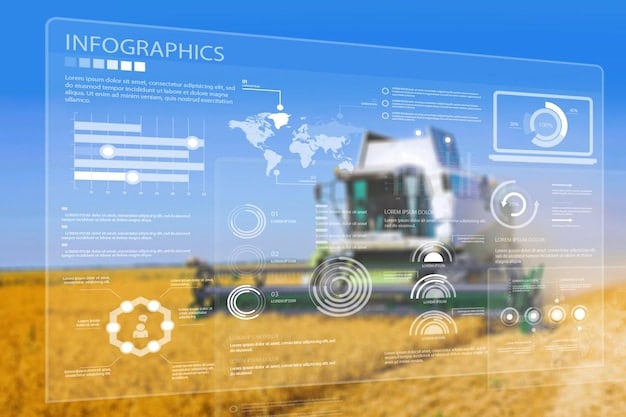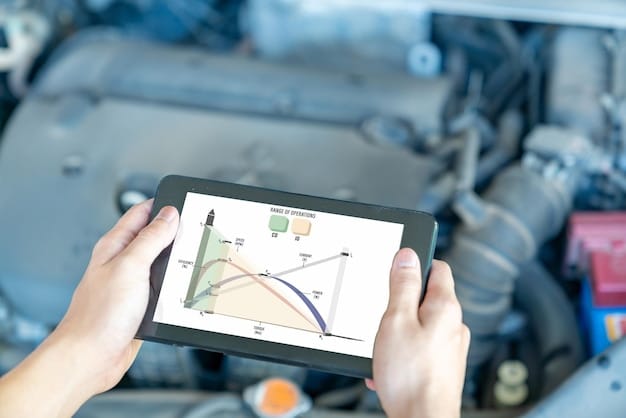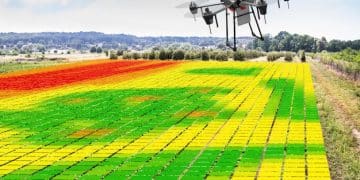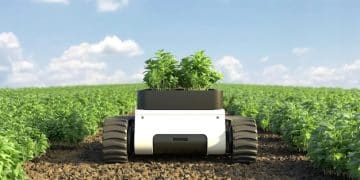Remote Diagnostics: Maximize Farm Equipment Productivity in the US

Remote diagnostics for farm equipment leverages technology to minimize downtime and maximize productivity by enabling real-time monitoring, proactive maintenance, and rapid troubleshooting of agricultural machinery in the US.
In today’s fast-paced agricultural landscape, keeping farm equipment running smoothly is crucial for productivity and profitability. Remote diagnostics for farm equipment emerges as a game-changing solution, minimizing downtime and ensuring optimal machinery performance.
Understanding Remote Diagnostics for Farm Equipment
Remote diagnostics is revolutionizing farm equipment maintenance in the US. It allows technicians and farm operators to monitor the health and performance of machinery from a distance, enabling proactive interventions and minimizing costly breakdowns.
This technology is more than just a convenience; it’s a necessity for modern farming operations aiming to optimize efficiency and reduce operational expenses.
Key Components of Remote Diagnostics
Remote diagnostics systems consist of several integrated components that work together to provide comprehensive monitoring and diagnostic capabilities.
- Sensors and Telematics: These devices collect real-time data on various parameters such as engine performance, hydraulic pressure, and fuel consumption.
- Data Transmission: Collected data is transmitted wirelessly to a central server or cloud platform via cellular, satellite, or Wi-Fi connections.
- Diagnostic Software: Advanced algorithms and software analyze the incoming data, identifying potential issues and predicting maintenance needs.
- User Interface: Farmers and technicians can access diagnostic information through user-friendly dashboards on computers, tablets, or smartphones.

By integrating these components, remote diagnostics systems provide a holistic view of farm equipment health, enabling informed decision-making and timely maintenance interventions.
Benefits of Remote Diagnostics in Agriculture
Implementing remote diagnostics brings a host of advantages to farming operations, from reducing downtime to enhancing overall productivity. These benefits directly impact the bottom line and sustainability of agricultural businesses in the US.
Farmers can achieve better operational efficiency, reduce maintenance costs, and extend the lifespan of their equipment.
Minimizing Downtime
One of the most significant benefits of remote diagnostics is the ability to minimize downtime. By identifying potential problems before they escalate, farmers can schedule maintenance during off-peak hours, avoiding disruptions to critical operations.
This proactive approach also reduces the likelihood of unexpected breakdowns, which can be particularly detrimental during planting or harvesting seasons.
Improving Equipment Performance
Remote diagnostics provides valuable insights into equipment performance, allowing farmers to optimize settings and usage patterns for maximum efficiency. By monitoring parameters such as fuel consumption and engine load, operators can identify areas for improvement.
Reducing Maintenance Costs
Predictive maintenance enabled by remote diagnostics can significantly reduce maintenance costs. Instead of following rigid maintenance schedules, farmers can perform maintenance only when it’s needed, based on real-time data and predictive analysis.
This targeted approach minimizes unnecessary maintenance and reduces the risk of costly repairs due to neglected issues.
Implementing Remote Diagnostics on Your Farm
Implementing remote diagnostics involves several key steps, from selecting the right equipment to training personnel and integrating the technology into existing workflows. Careful planning and execution are essential for a successful implementation.
Farmers need to assess their specific needs, evaluate available solutions, and develop a clear strategy for integrating remote diagnostics into their operations.
Choosing the Right System
Selecting the right remote diagnostics system depends on several factors, including the type of equipment, the size of the farm, and the specific needs of the operation. Consider factors such as data accuracy, ease of use, and compatibility with existing systems.
Conduct thorough research and compare different solutions to find the one that best fits your requirements and budget.
Training and Support
Proper training and ongoing support are crucial for the successful adoption of remote diagnostics. Ensure that all personnel involved in operating and maintaining equipment receive adequate training on the new system.
Establish a support network with the system provider to address any technical issues or questions that may arise.
Data Security and Privacy
Data security and privacy are paramount when implementing remote diagnostics. Farming operations generate a wealth of sensitive data that must be protected from unauthorized access.
- Encryption: Employ encryption techniques to secure data during transmission and storage.
- Access Controls: Implement strict access controls to limit who can access diagnostic information.
- Regular Audits: Conduct regular security audits to identify and address potential vulnerabilities.
By prioritizing data security and privacy, farmers can maintain trust in remote diagnostics and ensure the long-term success of the technology.
Challenges and Solutions in Remote Diagnostics
Despite its numerous benefits, remote diagnostics also presents certain challenges that farmers need to address. These challenges range from connectivity issues to data management and integration hurdles. By understanding these challenges and implementing effective solutions, farmers can unlock the full potential of remote diagnostics.
Farmers can expect connectivity issues, data overloads and integration complexities.

Connectivity Limitations
Reliable connectivity is essential for remote diagnostics to function effectively. However, many rural areas in the US suffer from limited or unreliable internet access. Connectivity limitations hinder data transmission and prevent real-time monitoring of farm equipment.
Farmers can explore alternative connectivity options, such as satellite internet or cellular boosters, to improve data transmission reliability.
Data Overload and Analysis
Remote diagnostics systems generate vast amounts of data, which can be overwhelming for farmers to manage and analyze. Identifying relevant insights from this data requires sophisticated analytical tools and expertise.
Farmers should choose systems with user-friendly interfaces and robust analytical capabilities to simplify data interpretation and decision-making.
Integration with Existing Systems
Integrating remote diagnostics with existing farm management systems can be challenging. Different systems may use incompatible data formats or communication protocols, hindering seamless data exchange.
Farmers should choose systems that support open standards and provide integration tools to facilitate data exchange with other systems.
Future Trends in Remote Diagnostics for Farm Equipment
Remote diagnostics is a rapidly evolving field with numerous exciting developments on the horizon. As technology advances, remote diagnostics systems will become more sophisticated, integrated, and user-friendly.
Artificial intelligence and machine learning are set to play a significant role in transforming remote diagnostics, as will increased connectivity and edge computing.
Artificial Intelligence (AI) and Machine Learning (ML)
AI and ML algorithms can analyze vast amounts of data to identify patterns and predict equipment failures with greater accuracy. These technologies can also automate diagnostic processes, reducing the need for manual intervention.
AI-powered systems can learn from past experiences and continuously improve their diagnostic capabilities over time.
Enhanced Connectivity
As connectivity infrastructure improves, remote diagnostics systems will be able to transmit larger volumes of data more quickly and reliably. This enhanced connectivity will enable real-time monitoring and remote control of farm equipment.
Edge Computing
Edge computing involves processing data closer to the source, reducing the need to transmit large volumes of data to a central server. This approach can improve response times and reduce bandwidth requirements.
Conclusion
Remote diagnostics is transforming farm equipment maintenance, enabling farmers to minimize downtime, improve equipment performance, and reduce maintenance costs. By understanding the benefits, challenges, and future trends of remote diagnostics, farmers can make informed decisions and implement the technology effectively.
| Key Point | Brief Description |
|---|---|
| 🚜 Minimize Downtime | Remote diagnostics allows early detection of issues, reducing unexpected breakdowns. |
| ⏱️ Improve Efficiency | Optimize equipment settings for peak performance and fuel conservation. |
| 💰 Reduce Costs | Targeted maintenance avoids unnecessary services and extends the lifespan of machinery. |
| 🌐 Future Trends | AI, enhanced connectivity and edge computing will boost efficiency in diagnostics. |
Frequently Asked Questions
Remote diagnostics uses sensors and data transmission to monitor farm equipment from afar, enabling technicians to diagnose issues and schedule maintenance proactively.
By identifying potential problems before they lead to breakdowns, remote diagnostics allows for timely maintenance, avoiding extended periods of equipment inactivity during crucial farming seasons.
These systems collect data on engine performance, fuel consumption, hydraulic pressure, temperature, and various other parameters, providing a comprehensive overview of equipment health and performance.
While adaptable to numerous machines, the suitability of remote diagnostics often depends on the specific equipment and the scope of farming operations. Newer models may have native compatibility.
Data security is prioritized through encryption and access controls. Regular security audits help spot and address vulnerabilities, keeping sensitive farm data protected from intrusions and unauthorized access.
Conclusion
By implementing remote diagnostics, farming operations in the US can achieve greater efficiency, reduce costs, and ensure the sustainability of their businesses. As technology continues to advance, remote diagnostics will play an increasingly important role in modern agriculture.





